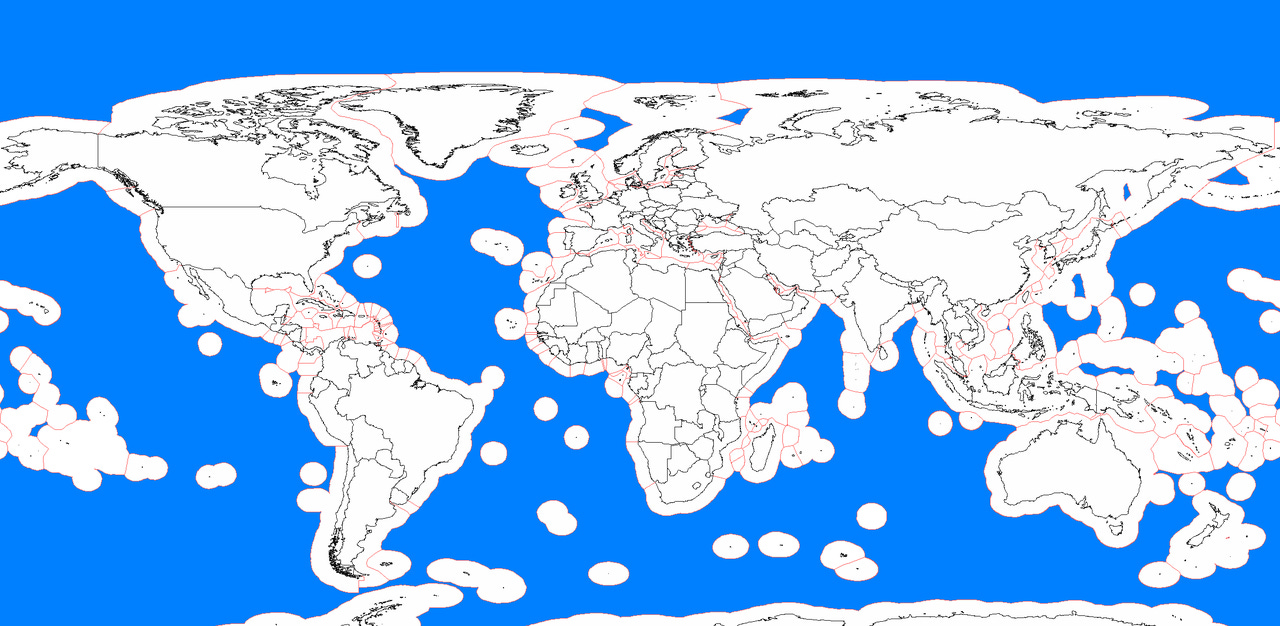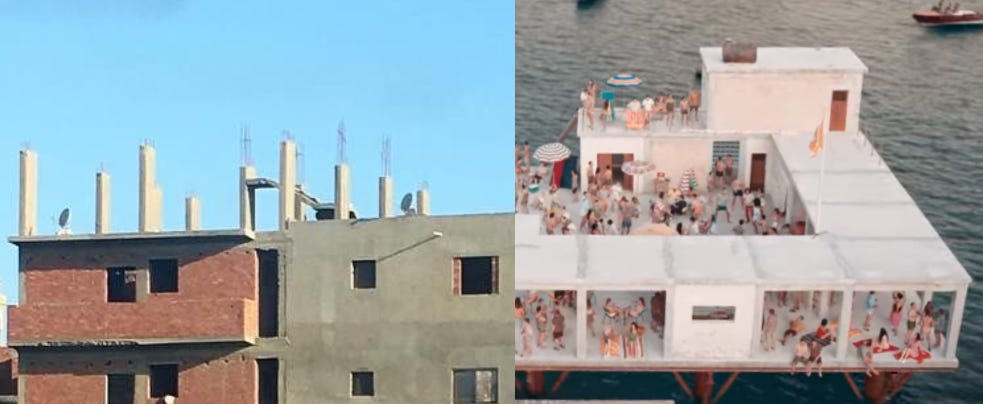Netflix has somehow liberalized filmmaking: it not only finances movies all over the world but also provides a platform for their international dissemination. A cool Italian movie which often might have never made it beyond national borders, is suddenly all the rage in our super-connected world. I happened to watch Rose Island this week and was struck by its overt juxtaposition of formal and informal aesthetics: the informal island versus the formal order of the Vatican or Strasbourg scenography; the self-built vehicle versus the corporate car.
Screencap from Rose Island
The movie tells the true story of the rise and fall of an informal, independent micronation outside of Italy’s territorial waters; one of numerous independent micronations that sprung out in the 60s. Considering that 50% of the planet’s surface is mare liberum - international waters that do not belong to any State’s jurisdiction - it is interesting how we do not see even more examples of independent sea steading. A handful of attempts seem to be pioneering the way to water based city-states; which never fail to remind me of Waterworld.
Map of International Waters (excluding Exclusive Economic Zones)
In Rose Island the island-structure “sprawls” at the periphery of international waters. In typical informal fashion, it locates itself on the outskirts of the city of Rimini; in doing so it is able to leverage the touristic crowds of the center, while enjoying the freedom often found in boundaries and borders. As most informal settlements it’s relationship to authority and formal governments isn’t clear.
Screencaps from Rose Island
The island itself is a simple structure which broadly reminds of informal houses built all over South America, North Africa or the Balkans. Rose Island grows during the movie, at some point getting a partial second floor - but always keeping the bare concrete structure, exposed brick and overall feeling of incompleteness. This resembles the informal typology where the aspiration and practical realities of the families inhabiting the houses are crucial to the construction morphology. Dwellings are periodically enlarged; additional floors are added with family members’ coming of age. Reinforcing bars typically stick out of the roof as a physical representation of hope and future.
Informal construction vs. screencap from Rose Island
An initial lack of formal organization does not mean that there isn’t a system of governance in place however. In informal settlements as well as in the Rose Island leadership there are implicit rules that participants have to follow. Often tacit norms and social conventions can be far more effective in organizing behavior and ordering spaces than legal systems. Ultimately authority resorts to all kinds of formal and informal behaviors to reassert control. In the movie after failing to bribe the protagonist by informally offering lucrative beach concessions in the seaside town of Rimini, the state bombards the microstate to smithereens. Yichtafel discusses the resolution of these grey space problems in urbanization. He mentions how informal settlements often inhabit a temporal reality positioned in between the whiteness of future legalization and the blackness of potential eviction and destruction; stuck between the formality of Euclidian pragmatic form and the lack of overt design intent.
Villa Savoye (1931), Rose Island (1968), Torre Velasca (1957)
Did you like this issue of thinkthinkthink? Consider sharing it with your network: Share
📚 One Book
Informalize by Marc Angélil & Reiner Hehl\ A nice collection of four essays concerning the developing importance of urban informality, giving interesting examples of the existing reality while trying to frame the concept into contemporary urban and economic theory. I think the book is well worth the read of anyone interested in informality, if not for the specific examples and original ideas, for the multiplicity of references and rich bibliography.
🔗 Three Links
Fluxopia: On Life in the Metabolic City by Luke Jones\ Reading cities through flows.
Why cities are not as bad for you as you think by Matthew Keegan\ On the health benefits of density.
How to Rebuild Cities for Caregiving by Leslie Kern\ On lock-in perspective in urban infrastructure.
🐤 Five Tweets
Vernacular architecture:
— Federico Italiano (@FedeItaliano76) December 19, 2020
1. Boat-shaped roofs of the Tongkonan—the traditional ancestral house of the Torajan people in South Sulawesi, Indonesia. Photograph by Geri Dagys https://t.co/uDTf5mQNgJ pic.twitter.com/eTYakTwVRY
I’ve been waiting for this one! Thank you Sam.
— Jordan Moore 𐃏 (@jordanmoore) January 13, 2020
P.S - I found this example of how games render scenes useful in triggering a headless glimpse. pic.twitter.com/5sUFe8s9V3
“In one teaspoon of soil, there are more microorganisms than there are people on the Earth.” pic.twitter.com/AvaZgiGyFq
— BBC Ideas💡 (@bbcideas) December 19, 2020
Everything is terrible but this gorgeous photo helped.
— Ed Yong (@edyong209) October 16, 2020
It's a 20 million-year-old ant.
The detail is magnificent, especially considering the cameras that were around at the time.
(Credit: Yuan Ji)https://t.co/tLRRJiDpNB
“My concern is with the rhythms of nature....I work inside out, like nature”—Jackson Pollock
— Manuel Lima (@mslima) July 2, 2020
Left:
Jackson Pollock, Autumn Rhythm: Number 30 , 1950, oil on canvas.
Right:
Graciela Blaum, Oaks, 2007, photography. pic.twitter.com/258ifWBbcd
This was the fourteenth issue of thinkthinkthink - a periodic newsletter by Joni Baboci on cities, science and complexity. If you really liked it why not subscribe?





